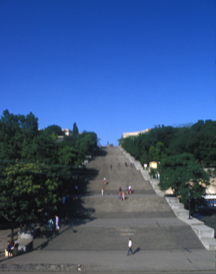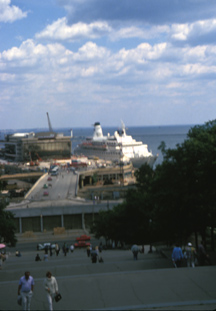If you like to travel, there is also a pretty good chance that you enjoy movies as well. After all many of us made our first “trips” in a theater seat. Our first tour guide to Rome may have been Fellini. In London, 221 Baker Street might be a more popular tourist site than 10 Downing Street. Who knows how many travelers have gone to Ireland seeking the sweeping panoramas of David Lean’s Ryan’s Daughter. Today, the erstwhile USSR exists mostly in the frames of Doctor Zhivago and Nicholas and Alexander . Only a couple of months ago I overheard one American tourist whisper to another as we stood before the imperial throne in Beijing’s forbidden City: “That’s the chair where The Last Emperor hid the cricket cage.” She too had come with images, even if fictional, of Bertolucci’s magnificent film.
There are, of course, numerous other film favorites that might be citied, among them Lost Horizon, Lawrence of Arabia, Exodus, The Last Time I Saw Paris, Apocalypse Now, Judgement At Nuremburg, The Year of Living Dangerously, Chinatown, the list is nearly infinite of times and places, past and present.
There’s a kinship between travel and the cinema. Movies transport us to far away places and times past. I climbed the bell towers of Notre Dame with three different hunchback’s (Lon Chaney, Charles Laughton and Anthony Quinn) before I got to do it myself. I fell in love with Audrey Hepburn in Roman Holiday;followed Julius Caesar to Cleopatra’s Alexandria; and landed on the beaches at Normandy with Robert Mitchum’s platoon. I had been all over the world and back and forth through the ages before I ever left my hometown. Movies didn’t sate my appetite for travel, they whetted it. More than that, they enriched my travels with curiosity, historical perspective and a sense of quest.

The steps from the seafront
©UrbisMedia

The Pacific Princess, not the Potempkin
©UrbisMedia
I was on a sort of pilgrimage when not long ago my ship pulled into the “Pearl of the Black Sea,” the city of Odessa, Ukraine. Odessa has interesting 19th century French Empire architecture, spas and medical clinics are numerous, and sites haunted by the likes of Gogol, Gorky and Pushkin. But my compelling interest was the Potyemskya Lestnitsa , the Potempkin Steps, where Sergei Eisenstein had filmed in 1925 the silent classic, The Battleship Potempkin , named for the ship that might have been berthed in 1905 where mine was now. From the quay there I could see the 192 steps and risers leading up from the harbor to the promontory on which the city stands.
I rushed past a phalanx of prostitutes and hawkers to the foot of the steps. As I began my ascent my mind began to screen what is perhaps the most famous montage in cinematic history when a crowd of civilian sympathizers is massacred by ranks of czarist soldiers. In 155 separate shots Eisenstein employed close-ups, long- shots, overlapping images, juxtapositions, elongating and repeating sequences. He varied tempo and bent time, applying the grammar of film to blur the line between the “reel” and the real.
This great director altered my sense of time as well. I half-expected to see the broken bodies of the victims in place of the groups of tourists. That famous baby carriage in the film, released from a dying mother to careened down the steps that are now lined with vendors carts. The bodies of victims draped over the steps where candy wrappers now cluster. It was the supreme moment of my trip: a conjunction of great urban architecture, history, and the cinematic art.
It didn’t diminish the romance of Odessa for me when I learned back home that the actual massacre did not happen at the Potempkin Steps. Sometimes travel, like movies, requires a little “willing suspension of disbelief.”
___________________________________
©2004, James A. Clapp (UrbisMedia Ltd. Pub. 2.6.2004)
